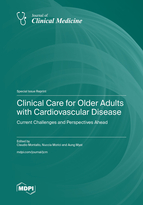Clinical Care for Older Adults with Cardiovascular Disease: Current Challenges and Perspectives Ahead
A special issue of Journal of Clinical Medicine (ISSN 2077-0383). This special issue belongs to the section "Cardiology".
Deadline for manuscript submissions: closed (20 February 2023) | Viewed by 22302
Special Issue Editors
2. Oxford Heart Center, Oxford University Hospital NHS Trust, Oxford, UK
Interests: tricuspid regurgitation; acute coronary syndromes; dual antiplatelet therapy; TAVI; aortic stenosis; MitraClip; elderly
Interests: cardiogenic shock; acute cardiac care; elderly
Interests: coronary intervention; structural intervention
Special Issue Information
Dear Colleagues,
Older adults represent a large portion of patients with acute coronary syndromes, and with cardiovascular diseases in general. Nonetheless, they are seldom included in randomized clinical trials, and therefore evidence to guide clinical decision making is often not generalizable to them. This is a problem with everyday clinical implications worldwide, and often results in the mis- or undertreatment of this large population of fragile individuals.
In this Special Issue of the Journal of Clinical Medicine, we aim to publish high-quality, scientifically robust studies that will enrich the literature on this topic, with special attention to areas with clinical implications and where little or no evidence is available.
We believe that such papers will be useful and instructive, and that they and will stimulate scientific discussion and advancement in this field.
Dr. Claudio Montalto
Dr. Nuccia Morici
Dr. Aung Myat
Guest Editors
Manuscript Submission Information
Manuscripts should be submitted online at www.mdpi.com by registering and logging in to this website. Once you are registered, click here to go to the submission form. Manuscripts can be submitted until the deadline. All submissions that pass pre-check are peer-reviewed. Accepted papers will be published continuously in the journal (as soon as accepted) and will be listed together on the special issue website. Research articles, review articles as well as short communications are invited. For planned papers, a title and short abstract (about 100 words) can be sent to the Editorial Office for announcement on this website.
Submitted manuscripts should not have been published previously, nor be under consideration for publication elsewhere (except conference proceedings papers). All manuscripts are thoroughly refereed through a single-blind peer-review process. A guide for authors and other relevant information for submission of manuscripts is available on the Instructions for Authors page. Journal of Clinical Medicine is an international peer-reviewed open access semimonthly journal published by MDPI.
Please visit the Instructions for Authors page before submitting a manuscript. The Article Processing Charge (APC) for publication in this open access journal is 2600 CHF (Swiss Francs). Submitted papers should be well formatted and use good English. Authors may use MDPI's English editing service prior to publication or during author revisions.
Keywords
- elderly
- older adults
- acute coronary syndromes
- ACS
- heart failure








